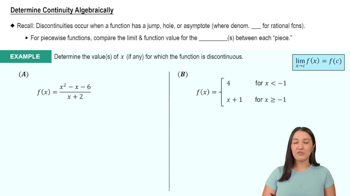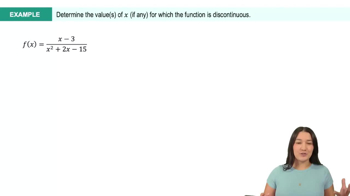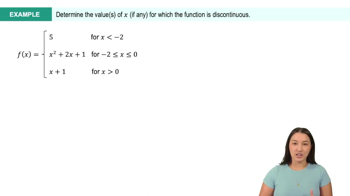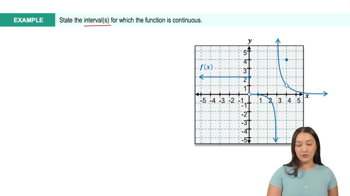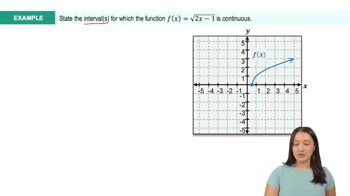Table of contents
- 0. Functions7h 52m
- Introduction to Functions16m
- Piecewise Functions10m
- Properties of Functions9m
- Common Functions1h 8m
- Transformations5m
- Combining Functions27m
- Exponent rules32m
- Exponential Functions28m
- Logarithmic Functions24m
- Properties of Logarithms34m
- Exponential & Logarithmic Equations35m
- Introduction to Trigonometric Functions38m
- Graphs of Trigonometric Functions44m
- Trigonometric Identities47m
- Inverse Trigonometric Functions48m
- 1. Limits and Continuity2h 2m
- 2. Intro to Derivatives1h 33m
- 3. Techniques of Differentiation3h 18m
- 4. Applications of Derivatives2h 38m
- 5. Graphical Applications of Derivatives6h 2m
- 6. Derivatives of Inverse, Exponential, & Logarithmic Functions2h 37m
- 7. Antiderivatives & Indefinite Integrals1h 26m
1. Limits and Continuity
Continuity
Problem 42
Textbook Question
Determine the interval(s) on which the following functions are continuous. At which finite endpoints of the intervals of continuity is f continuous from the left or continuous from the right?
f(x)=√25−x^2
 Verified step by step guidance
Verified step by step guidance1
<Step 1: Identify the domain of the function.> The function \( f(x) = \sqrt{25 - x^2} \) is defined when the expression under the square root is non-negative. Therefore, solve the inequality \( 25 - x^2 \geq 0 \).
<Step 2: Solve the inequality.> Rearrange the inequality to \( x^2 \leq 25 \). This implies \( -5 \leq x \leq 5 \). Thus, the domain of \( f(x) \) is the closed interval \([-5, 5]\).
<Step 3: Determine continuity within the interval.> The function \( f(x) = \sqrt{25 - x^2} \) is continuous wherever it is defined, as it is a composition of continuous functions (a polynomial and a square root function). Therefore, \( f(x) \) is continuous on the open interval \((-5, 5)\).
<Step 4: Check continuity at the endpoints.> At \( x = -5 \) and \( x = 5 \), check the one-sided limits. For \( x = -5 \), check if \( \lim_{x \to -5^+} f(x) = f(-5) \). For \( x = 5 \), check if \( \lim_{x \to 5^-} f(x) = f(5) \).
<Step 5: Conclude about one-sided continuity.> If the one-sided limits equal the function values at \( x = -5 \) and \( x = 5 \), then \( f(x) \) is continuous from the right at \( x = -5 \) and continuous from the left at \( x = 5 \).
Recommended similar problem, with video answer:
 Verified Solution
Verified SolutionThis video solution was recommended by our tutors as helpful for the problem above
Video duration:
3mPlay a video:
Was this helpful?
Key Concepts
Here are the essential concepts you must grasp in order to answer the question correctly.
Continuity of Functions
A function is continuous at a point if the limit of the function as it approaches that point equals the function's value at that point. For a function to be continuous over an interval, it must be continuous at every point within that interval. This concept is crucial for determining where a function does not have breaks, jumps, or asymptotes.
Recommended video:

Intro to Continuity
Endpoints of Intervals
Endpoints of intervals are the boundary points that define the start and end of an interval. When analyzing continuity, it is important to check the behavior of the function at these endpoints, as a function can be continuous from the left or right at these points. This means we need to evaluate one-sided limits to determine continuity at the endpoints.
Recommended video:
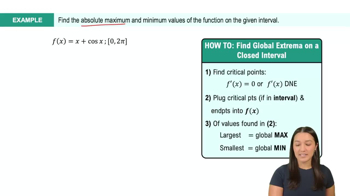
Finding Global Extrema (Extreme Value Theorem) Example 4
Square Root Function
The square root function, such as f(x) = √(25 - x^2), is defined only for non-negative values under the square root. This means that the expression inside the square root must be greater than or equal to zero for the function to be real-valued. Understanding the domain of the square root function is essential for identifying the intervals of continuity.
Recommended video:
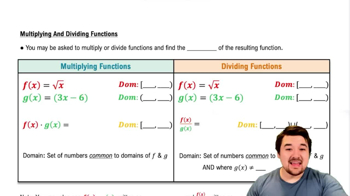
Multiplying & Dividing Functions
Related Videos
Related Practice




